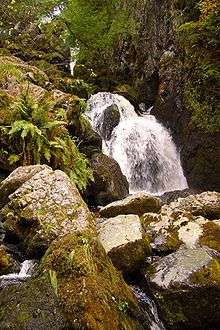Lodore Falls

Lodore Falls is a waterfall in Cumbria, England, close to Derwentwater and downstream from Watendlath. The falls are located on the beck that flows from Watendlath Tarn, and tumble more than 100 feet (30 m) over a steep cascade into the Borrowdale Valley.[1] Although it is spectacular in the rainy season, it can dry to a trickle in the summer.[2]
One of the earliest recorded visits to the 'Lodoar Falls' was by William Sawrey Gilpin in 1772 and he describes them as follows - "The stream falls through a chasm between two towering perpendicular rocks. The intermediate part, broken into large fragments, forms the rough bed of the cascade. Some of these fragments stretching out in shelves, hold a depth of soil sufficient for large trees. Among these broken rocks the stream finds its way through a fall of at least a hundred feet; and in heavy rains, the water is every way suited to the grandeur of the scene."[3] The rivulet is referred to as the 'Lodoar River' by Gilpin.[4]
A famous onomatopoeic poem, Cataract of Lodore, written by Robert Southey in 1820, was inspired by the falls and he seems to have fixed the spelling of the name.[1]
The falls are on private land and can be accessed via the Lodore Hotel for patrons or via the roadside path with an access also provided opposite the Mary Mount Hotel. The oak woodlands here are a Site Of Special Scientific Interest (SSSI).
References
- Notes
- 1 2 "Lodore Falls in Borrowdale". Retrieved 2008-07-19.
- ↑ "Lodore Falls- Keswick, Cumbria". Archived from the original on 2008-08-08. Retrieved 2008-07-19.
- ↑ Gilpin, Page 191
- ↑ Gilpin, Page 192
- Sources
- Gilpin, William (1786). Observations relative chiefly to Picturesque Beauty made in the year 1772, On Several Parts of England; Particularly the Mountains, and Lakes of Cumberland, and Westmorland. London : R. Blamire.
Coordinates: 54°33′27″N 3°08′16″W / 54.5576°N 3.1378°W
External links
| Wikimedia Commons has media related to Lodore Falls, Cumbria. |